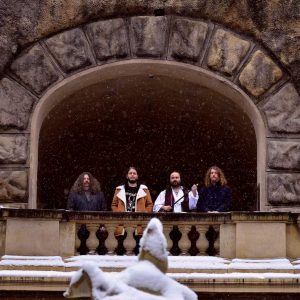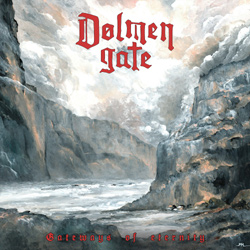SVARTSOT (Eng.)
– Hello, thanks for your time. What are SVARTSOT currently up to?
We’re taking a break for the summer right now. Apart from recording the album, we’ve had a good few shows here in Denmark this year. We hadn’t managed to practice so often together though, so we managed to get a weekend together in the rehearsal room and will now be taking around a month’s break before practicing together another time and starting in mid-August on the shows for the last part of the year.
– Though you have already released some full-length albums I guess they may be some people who don’t know you yet so, could you please make some history of the band?
The band started early in 2005 after he band’s predecessor ceased to exist. Right from the start we mixed folk and medieval music with metal, but we didn’t use folk instruments in the beginning. That first came about when our original whistler joined in the summer of 2005. Also the lyrical and vocal concepts were laid from the start. Our lyrics are always in Danish and are influenced mainly by Danish folklore and history. The vocal style has also always predominantly been growl.
The band released a couple of demos (Svundne Tider, recorded in 2005, and Tvende Ravne, recorded in 2006). Napalm Records then contacted us in 2007, and we signed with them and released the debut, Ravnenes Saga, later that same year. 2008 was spent gigging in Denmark and around Europe, but ended in quite some turbulence. Firstly our original whistler announced that he would take a break from the band due to his wife’s ill health. Then less than a month after the four other guys in the band announced that they too were leaving. In retrospect this is something that had been building up over several months.
Over the next 2 months I recruited new musicians, and the line-up was again complete by mid-February 2009 and ready to play the first show by early March 2009. That year was relatively quiet, as it was important to consolidate the new line-up and to replace a half album’s worth of material that had been dropped when the old line-up split. The second album, Mulmets Viser, was recorded in October 2009 and released in March 2010. We played several important shows in the wake of that album, including 2 Paganfest extended shows (Stuttgart and Tilburg), Napalm Records’ 15th anniversary show at Metalfest Austria, part of Negură Bunget’s Spirit of the Land tour and Wacken Open Air. We also spent the year writing material for the third album, maledictus  eris, and we recorded this in March this year.
eris, and we recorded this in March this year.
– «Svartsot» stands for «black sickness» in Danish, a quite aggressive and sad name for such a «happy» music. Why did you choose that name?
That is correct; “svartsot” was once a term for a type of jaundice-related liver disease which turned the patient’s skin turned blackish. Apparently the illness was quite deadly. We first came across the word in the predecessor to Svartsot, and considered using it as a song title/theme, but we decided to use it as the band name when we started Svartsot. It kinda fit in well with some of the black metal influences we had back then.
I’ll grant you that the first two albums had maybe a quite jaunty feel to some of the material, but the name seems maybe even more fitting for the present album. Not that the jaundice-like disease and the Black Death have anything to do with each other though. But the music has certainly become less jolly. Besides that we’ve always had a more brutal approach to folk metal than many other bands in the genre, so maybe it’s never been that misplaced…
– And what are your main musical influences?
They are many and varied. I don’t think I can say that we have a few major influences that can be named in terms of bands. So it’s probably best for the listener to try to work them out. We have often been likened to Amon Amarth, and I have seen a couple Eluveitie references for the new album, but I can safely say that these two bands have NOT been direct  influences for the music I have written for this album.
influences for the music I have written for this album.
– Your new «Maledictus Eris» will come out later this month. What are your expectations with it?
I think it is best not to have expectations, because then you won’t be disappointed if the goal isn’t reached. Of course we want this album to be successful, and we believe in what we do is good. It would be pointless to put out albums if you didn’t.
– And how could you describe the sound on the album?
In comparison to the first two albums, this one is much more mature and complex. It has a lot of textures and layers, and isn’t as 2-dimensional as the earlier material. Especially the first album was plagued by very little difference between the whistle parts and the guitar parts, which made the album immediately digestible, but extremely boring in the long run.
There are heavy influences from medieval music in the melodies, and we have aimed to make the guitars as heavy as possible. But there is still a lot of room for all of the instruments to breathe. Lasse Lammert’s aim this time was to get the album to sound even more natural yet heavy than the last one, and I think he has done an extremely good job of it. It doesn’t sound like a standard metal album.
– All your records so far have followed a similar pattern but, what’s new on «Maledictus Eris»?
maledictus eris doesn’t follow the patterns we had on the first two. Of course, there are threads going right back to the beginning of the band, but I really feel we have come a long way since then. On this album we have tried a lot of new things (for us at least) and experimented more with ideas we’ve worked with before, such as more varied and even clean vocals, the use of Swedish bagpipes, and generally more acoustic instrumentation. The general style of the songs has also changed since the last album and they generally have more complicated structures.
– And how was the songwriting for this album like?
It wasn’t that different to the other two albums in the respect that I started by playing around with melodies and perfecting them before going on to harmonies, counterpoint harmonies and chordwork. The music is always written first and then lyrics are written afterwards so that they marry perfectly with each other. This time around James wrote all of the lyrics in his native English before I translated them to Danish. Hans-Jørgen also contributed with the melody for the album intro. Once the tracks were written they were sent out to the rest of the band, and they were given the opportunity to arrange their own parts so as to give them more of their own personalities.
playing around with melodies and perfecting them before going on to harmonies, counterpoint harmonies and chordwork. The music is always written first and then lyrics are written afterwards so that they marry perfectly with each other. This time around James wrote all of the lyrics in his native English before I translated them to Danish. Hans-Jørgen also contributed with the melody for the album intro. Once the tracks were written they were sent out to the rest of the band, and they were given the opportunity to arrange their own parts so as to give them more of their own personalities.
– In these years of existence for SVARTSOT, what has been the best and the worst thing the band has experienced?
There have been many good things, so it’s hard to choose. Getting to play shows like the two Paganfest extended shows or Wacken have been amazing, but also hearing a new album come into being has to be up there too.
There are of course always negative sides to everything. The aftermath of the big split we had in 2008 was a tough one to come through. But also reading half-baked reviews by reviewers who haven’t bothered to listen to an album properly is always a low point: Especially when they don’t even seem to relate to the album, but could’ve been copied from another reviewer’s review of an earlier album. I would have hoped that this album is different this album was different enough from the first two that this wouldn’t happen… This style of reviewing always ends in medium marks, because it’s safest and because maybe no-one will notice that the reviewer hasn’t done their job properly.
– We don’t know many bands of your style from Denmark; what bands could you suggest us?
There aren’t really that many. The folk metal scene in general is very small  here. There weren’t really any other folk metal bands from Denmark when we started – with the exception of Wuthering Heights and Týr, the latter of which are from the Faeroes which is a dependency of Denmark.
here. There weren’t really any other folk metal bands from Denmark when we started – with the exception of Wuthering Heights and Týr, the latter of which are from the Faeroes which is a dependency of Denmark.
Over the past three-four years a few folk metal bands have been started, but only a couple have so far put out albums. Time will show how they get on, but one or two of them seem to be promising.
– Anyway, Folk Metal seems to be growing day by day into the Metal scene. What do you think is its secret recipe?
This is quite a popular question – I’ve been asked it in other interviews. I guess it’s for the same reasons as we decided to start playing folk metal in the first place – it is fun music to play and hear. Several of the more popular folk metal bands play maybe a less “serious” take on folk metal, and I think we did in the start too, although we have maybe always been a bit more extreme than most other folk metal bands. But the more “serious” side of folk metal is also becoming popular. And I think that is definitely the direction the more mature version of Svartsot is headed.
– And finally, what are the near-future plans for the band? I saw you have several dates in Denmark but, will you tour any other countries?
We’ve had some problems with bookers over the past year or so, and we ended up ending our contracts with both our domestic and international bookers last year. We are now working with a new booker for Denmark, and he has been extremely successful in getting us shows here. This is a good thing in many ways, as we haven’t had much chance to play here at home for the past few years. But we have not yet found a suitable agent for international booking. Of course we hope this will change once the new album is released, but until then we only have limited possibilities of playing outside of Denmark.
– That’s all, thank you once more. If you want to add some final words, feel free to do it.
We just hope that new and old fans alike will take kindly to the new direction the band is heading in. It’s maybe a bit difficult to compare the new album with the older ones, as there has been quite a major development in the music. And don’t trust a half-hearted review, because the reviewer maybe hasn’t understood the music. Give it a listen first and make your own decisions 🙂







